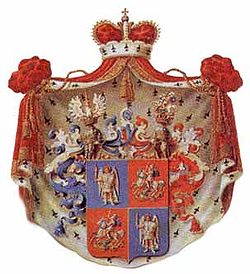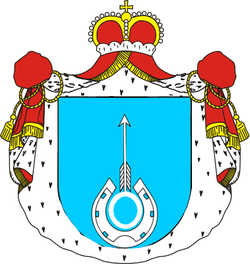- Svyatopolk-Mirsky family
-
Nikolai Ivanovitch Sviatopolk-Mirskii and his descendants used a variation of the Białynia Coat of Arms

Svyatopolk-Mirsky (Belarusian: Святаполк-Мірскі, Polish: Światopełk-Mirski) is a family of Belarusian and Polish nobility that originated from northwestern Belarus.
They first appeared in the Grand Duchy of Lithuania in the late 15th century as Mirski, a name probably derived from the town of Miory in the former Kievan Rus principate of Polotsk, although it is possible that the family had been local rulers for some centuries beforehand. The Memoirs of Prince Dolgoroukoff assert that the Swiatopelk-Mirskis were princes descending from Rurik who submitted to Gediminas & became magnates. The Genealogisches Handbuch der fürstlichen Häuser states that the Swiatopolk-Mirsky family descends from a younger branch of the Princes of Turov. Two members of the family, Boguslaw & Stanislaw, were representatives at the Great Sejm in 1791 {Polski Slownik Biograficzny}. Tomasz Bogumil Jan Swiatopelk-Mirski (1788-1868) fought in the 1830 Rebellion near Suwalki & fled into exile in Paris, where he both represented the interests of the exiled Poles in France & attempted to seek pardon from the Tsar. He was an active participant in the French colonization of Algiers, where he received a large grant of land & allegedly suggested the formation of the French Foreign Legion in order to reduce the burden of Polish exiles on the French state. He converted to Orthodoxy from Roman Catholicism, was regarded as a traitor by his fellow Polish rebels for his outspoken support of Panslavism,and was eventually allowed to return to Russia, where he remained under house arrest until his death {Polski Slownik Biograficzny}. His sons Dmitri & Nikolai were educated as members of the Russian nobility & had distinguished military careers. Tomasz Bogumil Jan claimed a Rurikid descent (according to his claim, Mirskis were descendants of Sviatopolk I of Kiev, hence the Sviatopolk part of the family name), but his claims were rejected by leading genealogists of Poland and Russia in the 19th century. Despite this, his pro-Russian attitudes and allegiance to the Tsars earned his branch of the family the confirmation of their dubious princely title by Alexander II of Russia in 1861 although the Senate of the Polish Kingdom had previously confirmed it in 1821{Polski Slownik Biograficzny}. Nikolai bought the historic castle of Mir in 1895 due to its name, the family having no historic connection with it {Dzieje Rezydencji na Dawnych Kresach Rzeczpospolitej}. Other branches of the family remained Polish by choice & retained estates near Braslaw & Miory until 1940, including Zajnow, Kamienpol, Leonpol & Miedzyrzec. Adam Napoleon Mirski of Zawierz & his sister Maria were painted by Jan Rustem in 1808 {Jan Rustem 'Portrait of Maria Mirska, Adam Napoleon Mirski & Barbara Szumska' c1808, oil on canvas, National Museum, Warsaw}. Adam was apparently highly regarded by his peasants as they rose in support of him during a local uprising in the 1840s. Tomasz Mirski (d 1852, not the same Tomasz as above) was an officer in Napoleon's Polish cavalry. Father Eugeniusz Swiatopelk-Mirski was murdered by the Bolsheviks in Mogilev in 1918 {http://www.kul.pl/dzwonkowski/s3.html}. Father Antoni Swiatopelk-Mirski SJ (1907-1942) was martyred at Auschwitz by the Nazis & has recently been advanced by the Vatican as a candidate for beatification {http://college.holycross.edu/faculty/vlapomar/hiatt/kill.htm}. Two teenage members of the family. Krysztof & Michal, were killed in the 1944 Warsaw Uprising {Polski Slownik Biograficzny} & another family member fought at Monte Cassino {personal communication regarding her late father by family member}. The Polish family suffered heavily in the Russian occupation of the Polish eastern provinces & few remain today, with representatives in the UK, Australia & Poland. There are representatives of the Russian family in the UK, USA, Brazil & France{personal knowledge from various family members}.
Among most notable Sviatopolk-Mirskies are:
- Thomas Bogumile Jean Sviatopolk-Mirskii (1788—1868) — ambassador of Polish Diet to Russia.
- Dmitry Ivanovitch Sviatopolk-Mirskii (1825—1899), son of Thomas Bogumile Jean — Russian Infantry General and politician, hero of the Caucasus and Russo-Turkish wars, member of the State Council of Imperial Russia;
- Nikolai Ivanovitch Sviatopolk-Mirskii, (1833—1898), a younger brother of Dmitry Ivanovitch — hero of the Caucasus and Russo-Turkish wars, ataman of the Don Cossack Voisko, member of the State Council of Imperial Russia
- Pyotr Dmitrievich Sviatopolk-Mirskii (1857—1914), son of Dmitry Ivanovitch — the governor of Penza and Vilna gubernias, Minister of Interior of Russia.
- Dmitry Petrovich Mirsky (1890—1939, pen name Dmitry S. Mirsky), son of Pyotr Dmitrievich — Russian writer, historian and essayist
External links
- Genealogical tree — in Russian
- History of the family — in Russian
- Biography of Dmitry Petrovich Sviatopolk-Mirskii — in English
Categories:- Russian noble families
- Polish noble families
- Surnames
- Belarusian nobility
- Russian people of Belarusian descent
- Polish people of Belarusian descent
Wikimedia Foundation. 2010.


